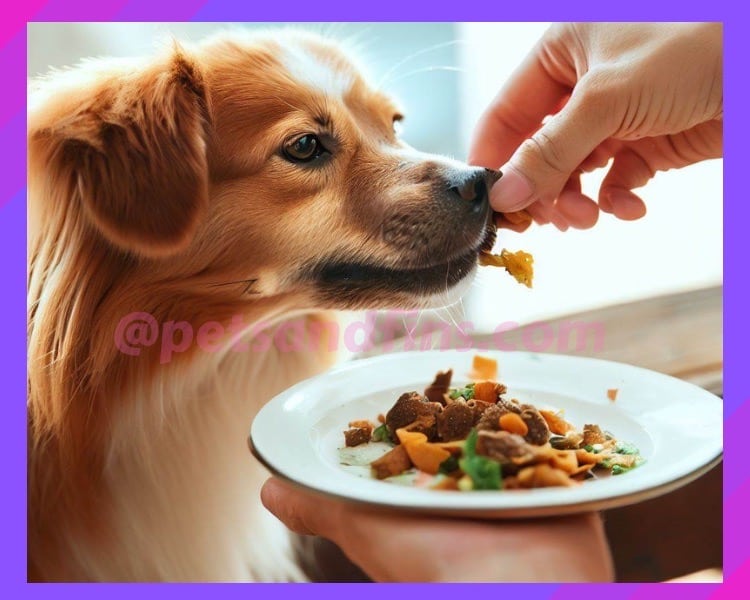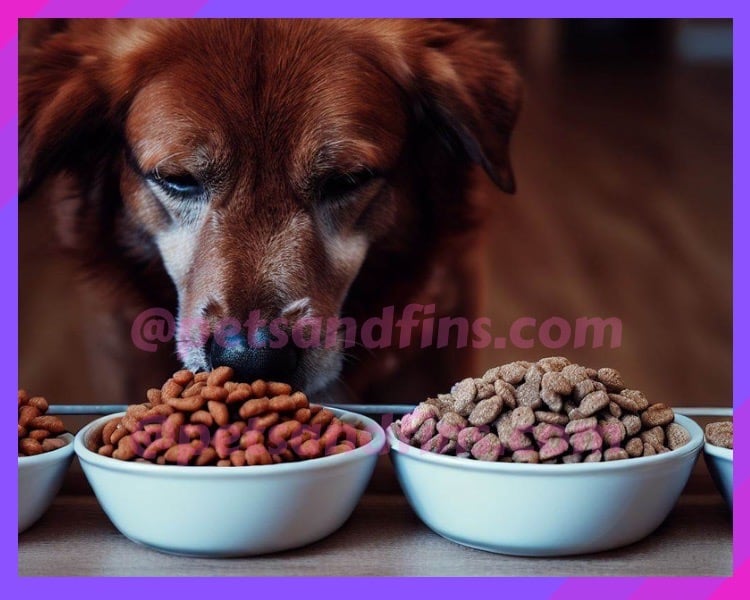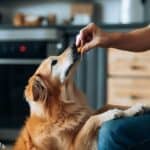Does your dog seem to have lost interest in their dry food? Before you give up and switch to wet food, consider these 15 Shocking Reasons Why Your Dog Is Refusing Dry Food.
As a pet owner, it can be concerning and frustrating when your dog refuses to eat their dry food. You may be left wondering why your dog won’t eat dry food, and what you can do about it.
In this blog post, I will explore 15 shocking reasons why your dog is refusing to eat dry food, and offer solutions to help you get your dog back to its healthy eating habits.
1. Boredom
Just like humans, dogs can get bored with their food. Eating the same dry food day after day can become monotonous, leading to a lack of interest in eating.
To combat boredom, try switching up your dog’s food by offering different flavors or brands. Additionally, you can add variety by incorporating wet food or toppers.
Solution: Rotate the type of food you give your dog and mix up the flavors. Try introducing new flavors slowly to see which ones they prefer. You can also consider adding wet food or toppers to provide a change in texture and taste.

2. Overfeeding
Overfeeding your dog can cause them to become picky with their food. When a dog is constantly given treats or table scraps, it may lose its appetite for its regular dry food.
Additionally, if your dog is overweight, it may have a decreased appetite due to a lack of physical activity.
Solution: Measure out the appropriate amount of food for your dog based on their size, age, and activity level. Limit treats and table scraps, and encourage exercise to maintain a healthy weight and appetite.

3. Dental Problems
Dental problems can make it difficult for dogs to eat dry food. Broken or loose teeth, gum disease, and other dental issues can cause pain and discomfort when chewing dry kibble.
Solution: Schedule regular dental check-ups with your veterinarian to ensure your dog’s teeth and gums are healthy.
Consider switching to a softer, more palatable food or soaking dry food in water to make it easier to chew.

4. Sickness or Medication
Certain medications can affect your dog’s appetite and make dry food less appealing. For example, antibiotics and pain medications may cause nausea or stomach upset, while steroids can increase your dog’s appetite.
Solution: Talk to your veterinarian about any medications your dog is taking and ask if they may be affecting their appetite.
They may be able to adjust the dosage or prescribe a different medication that won’t interfere with your dog’s appetite.
5. Age
As dogs age, their sense of smell and taste can decline, making dry food less appealing. Additionally, older dogs may have dental problems or difficulty chewing.
Solution: Consider switching to a senior-specific dry food that is formulated to meet the nutritional needs of ageing dogs. Soften dry food with water or add wet food or toppers for added flavor and texture.

6. Health Issues
Health issues such as gastrointestinal problems, food allergies, or kidney disease can cause a loss of appetite or make your dog avoid certain types of food, including dry food.
Solution: Consult with your veterinarian to identify and treat any underlying health issues. They may recommend a special diet or supplements to support your dog’s health and appetite.
They may recommend a special diet or medication to help your dog feel better and regain their appetite.
7. Anxiety and Stress
Dogs, just like humans, can experience anxiety and stress. These emotions can cause loss of appetite or refusal to eat dry food.
Anxiety and stress can be triggered by various factors such as changes in routine, loud noises, or new people or pets in the household.
Solution: Try to identify the cause of your dog’s anxiety or stress and remove it if possible. You can also consider using calming supplements or pheromone sprays to help your dog relax.
Offering a safe and comfortable space for your dog to eat can also help reduce anxiety.

8. Allergies
Food allergies or sensitivities can cause your dog to avoid dry food, particularly if they experience symptoms such as itching, diarrhea, vomiting, or other digestive issues.
These reactions can be caused by certain ingredients in the food, such as grains, chicken, or beef.
Solution: Work with your veterinarian to identify any food allergies your dog may have. You can switch to a limited ingredient diet or a novel protein source, such as fish or venison, to determine if your dog has a food allergy or sensitivity.
Alternatively, you can try hypoallergenic dog food that is designed to be free of common allergens.
9.Lack Of Feeding Schedule
Your dog may not be eating their dry food because they are not on a consistent feeding schedule.
Solution: Establish a regular feeding schedule that works for both you and your dog. Stick to the schedule and avoid leaving food out for extended periods of time.

10.Temperature Preference Issues
Some dogs prefer their food to be served at a specific temperature, and may refuse to eat if their food is too hot or too cold.
Solution: Experiment with serving your dog’s food at different temperatures until you find what they prefer. Most dogs prefer room-temperature food.
11.Texture Preference Issues
Some dogs have a preference for a specific texture of food, such as kibble versus canned food.
Solution: Offer your dog different types of dry food to see if they have a preference for a particular texture. You can also try adding warm water to the dry food to soften it and make it more appealing.

12.Seasonal Changes
Just like humans, dogs may have changes in appetite depending on the weather and seasonal changes. For example, during hot summer months, dogs may prefer lighter, more refreshing foods such as wet food or raw food, rather than dry kibble.
Conversely, during cold winter months, dogs may prefer warm, hearty meals that are more calorie-dense. As a pet owner, it’s important to be aware of these seasonal changes and adjust your dog’s diet accordingly.
Solution: If you notice that your dog’s appetite changes with the seasons, try adjusting its diet to fit its preferences.
Offer wet food or raw food during the summer months, and consider adding a warm topper to their dry food during the winter.
Additionally, make sure your dog always has access to fresh water, especially during hot weather when they may be more prone to dehydration.
13.Incorrect Food Bowl Location
The location of your dog’s food bowl can also play a role in their willingness to eat dry food. Some dogs may be hesitant to eat if their bowl is in a noisy or high-traffic area of your home.
It’s important to choose a quiet and peaceful spot for your dog’s mealtime.
Solution: Try relocating your dog’s food bowl to a more peaceful area of your home. This could be a quiet corner of the kitchen or a designated feeding area in a less busy room.
Additionally, you can try placing a mat or rug under the bowl to create a designated eating space for your dog.

14 .Food aversion
Dogs can develop a dislike for a particular type or brand of dry food due to a bad experience. For example, if your dog gets sick after eating a certain type of dry food, they may develop an aversion to it.
Solution: If you suspect your dog has a food aversion, it’s important to work with your veterinarian to determine the underlying cause and develop a plan to address it.
In some cases, a gradual reintroduction to the food may be necessary, while in others, a switch to a different type of food may be needed.
15. Lack Of Exercise
Dogs that don’t get enough exercise may have a lower appetite and may be less interested in eating dry food. This is especially true for high-energy breeds like Labrador Retrievers, Golden Retrievers, and German Shepherds.
If your dog isn’t getting enough exercise, they may not feel hungry enough to eat their dry food.
Solution:
Make sure your dog is getting enough exercise every day. This can include taking them for daily walks or runs, playing fetch, or taking them to the dog park.
The amount of exercise your dog needs will depend on their breed, age, and overall health, so talk to your veterinarian to determine the best exercise plan for your dog.
In addition to exercise, providing mental stimulation through games and toys can also help increase your dog’s appetite.
Try hiding pieces of kibble around the house or using puzzle toys to keep your dog mentally stimulated and engaged. This can also help prevent boredom and destructive behavior.

You Might Also Like 👉🏻👉🏻 25 Quick And Easy Tips To Make Your Dog Eat Dry Dog Food .
Key Takeaways
In conclusion, there are many reasons why your dog may not be eating dry food. It could be due to health problems such as dental issues or gastrointestinal disorders.
Texture and flavor preference also play a significant role in your dog’s food choices. Some dogs may prefer wet or raw food over dry kibble, while others may have specific taste preferences.
Feeding habits and routines can also affect your dog’s appetite for dry food. If you’re feeding your dog table scraps or treats throughout the day, they may not be hungry enough to eat their regular meals.
It’s important to pay attention to your dog’s eating habits and make adjustments accordingly. If you suspect a health problem, consult with your veterinarian for proper diagnosis and treatment options.
Experiment with different textures and flavors of dry food to find what works best for your furry friend. Establishing a consistent feeding routine can also help encourage healthy eating habits.
Overall, understanding the reasons behind why your dog won’t eat dry food can help improve their overall health and well-being.
why is my dog not eating his food but will eat treats ?

There could be various reasons why your dog is not eating his food but will eat treats. One common reason is that the dog may be experiencing dental issues or mouth pain that makes it difficult for him to eat his regular food.
Another reason could be that the dog is simply being picky or bored with his regular diet and is looking for something different or more exciting.
Another possible reason is that the dog may be experiencing stress or anxiety, which can cause a loss of appetite. If there have been any recent changes in the dog’s environment, such as a move or the addition of a new family member, it could be causing stress that is affecting the dog’s eating habits.
It is important to note that while treats can be a good way to entice a picky eater, they should not be used as a substitute for a balanced and complete diet.
If your dog is consistently refusing his regular food, it is best to consult with a veterinarian to rule out any underlying health issues and to discuss potential dietary changes or solutions.
My dog stopped eating dry food but eats wet food. What to do ?
Firstly, it is important to rule out any underlying health issues that may be causing your dog’s loss of appetite. A visit to the vet can help identify any potential medical problems that need to be addressed.
Assuming there are no health concerns, it could simply be a matter of preference. Some dogs may prefer the taste or texture of wet food over dry food.
In this case, switching to wet food permanently may be a viable solution. Alternatively, you can try mixing wet and dry food together to create a more appealing meal for your dog.
Gradually increasing the amount of wet food in the mix until they are solely eating wet food can also help with the transition.
It is important to note that if you do decide to switch your dog’s diet from dry to wet food, you should do so gradually over a period of several days or even weeks.
Abrupt changes in diet can cause digestive upset and other health issues. In conclusion, while it can be concerning when your dog stops eating their usual dry food, there are several solutions available.
Consulting with a veterinarian and experimenting with different types of foods can help ensure that your dog remains healthy and happy.
References:
1) Case, L.P., Daristotle, L., Hayek, M.G., & Raasch, M.F. (2011). Canine and feline nutrition: A resource for companion animal professionals (3rd ed.). St Louis: Mosby Elsevier.
2) Freeman, L.M., Michel, K.E., & Bartges J.W. (Eds.). (2011). Nutritional management of hospitalized small animals. John Wiley & Sons.
3) Laflamme D.P., Abood S.K., Fascetti A.J., et al. (2008). Pet feeding practices of dog and cat owners in the United States and Australia.Journal of the American Veterinary Medical Association 232(5): 687-694.
4) National Research Council (US) Subcommittee on Dog Nutrition.(2006). Nutrient requirements of dogs and cats.Washington (DC): National Academies Press (US).
5) Why Won’t My Dog Eat Dry Dog Food? https://www.purina.com/articles/dog/feeding/why-wont-my-dog-eat-dry-dog-food
